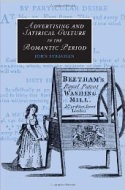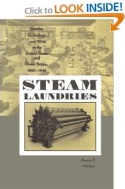-
History of:
- Resources about:
- More:
- Baby walkers
- Bakehouses
- Bed warmers
- Beer, ale mullers
- Besoms, broom-making
- Box, cabinet, and press beds
- Butter crocks, coolers
- Candle snuffers, tallow
- Clothes horses, airers
- Cooking on a peat fire
- Drying grounds
- Enamel cookware
- Fireplaces
- Irons for frills & ruffles
- Knitting sheaths, belts
- Laundry starch
- Log cabin beds
- Lye and chamber-lye
- Mangles
- Marseilles quilts
- Medieval beds
- Rag rugs
- Rushlights, dips & nips
- Straw mattresses
- Sugar cutters - nips & tongs
- Tablecloths
- Tinderboxes
- Washing bats and beetles
- Washing dollies
- List of all articles
Subscribe to RSS feed or get email updates.
Writers, if you find my research useful, a mention of this website would be appreciated. And if you make use of my article(s) for something you're publishing online, a link back would be nice. Thank you!
John Strachan, Advertising and Satirical Culture in the Romantic Period, from Amazon.comor Amazon UK

Arwen Mohun, Steam Laundries: Gender, Technology, and Work in the United States and Great Britain, 1880-1940, from Amazon.comor Amazon UK

Notes and sources for washing machine history
Before 1700
Jacopo Strada, (Octavius Strada, Benjamin Bramer): Kunstliche Abriss allerhand Wasser- Wind- Ross- vnd Handt Mühlen, beneben schönen vnd nützlichen Pompen, auch andern Machinen, damit das Wasser in Höhe zuerheben ... Durch den Truck publicirt ... durch Octauium de Strada à Rosberg ... Iacobi ... nepotem. Frankfurt, 2 volumes, 1617 and 1618. Later editions in German and French too.
British Library catalogue - search with [STRADA, Jacobus de]
Pictures from the first volume of the Strada book here.
Strada's "washing machine" is described in Ancliffe Prince's
The Craft of Laundering
as beaters agitating water in a trough heated by a kiln beneath, operated by a handwheel,
according to Lee Maxwell's
Save Women's Lives: History of Washing Machines
Robert Hooke's diary for
1677 refers to "Sir John Hoskins's way of rinsing fine linen in a whip-cord bag,
fastened at one end and strained by a wheel & cylinder at the other....whereby the
finest linen is washt wrung and not hurt.", according to Pamela Sambrook's
Country House Servant.
The 1691 "invention" seems to have been a mechanism for pounding things. It was described as an "engine" whose potential uses were "oiling and dressing leather and cloth, raising water, washing clothes, milling sugar canes, pounding minerals, pounding and bruising seeds, pounding charcoal, pounding rags to make paper". (McKenzie and Bell) The patent went to John Tyzacke, an associate of Thomas Neale, a man so full of entrepreneurial schemes that he was called the "great projector".
- McKenzie and Bell's A Chronology and Calendar of Documents Relating to the London Book Trade
- The 1690s Patents Boom: Invention or Stock-Jobbing? Christine Macleod The Economic History Review New Series, Vol. 39, No. 4 (Nov., 1986), pp. 549-571 Published by: Blackwell Publishing on behalf of the Economic History Society
- Christine MacLeod,
Inventing the Industrial Revolution: The English Patent System, 1660-1800
, Cambridge 2002
- Subject-matter index of specifications of patents 1617 - 1852, Patent Office, London, 1857
1700-1775
- Deutsches Museum, Der Regensburger Superintendent Jacob Christian Schäffer und die Prähistorie der Waschmaschine, 1998
- Gentleman's magazine and historical chronicle, Volume 22, January 1752
- Jacob Christian Schäffer, Die bequeme und höchstvortheilhafte Waschmaschine, 1766
- Jacob Christian Schäffer, Briefe eines Frauenzimmers, 1767
1775-1800
- Subject-matter index of specifications of patents 1617 - 1852, Patent Office, London, 1857
- Observations on the utility of patents, and on the sentiments of Lord Kenyon respecting that subject. Including free remarks on Mr. Beetham's patent washing mills; and hints to those who solicit for patents, London, 1791 (Author surely Beetham - "blatant piece of self promotion") - also see reviews pictured on Edward Beetham page
- Patents for Inventions - 1859 guide to British textile patents
- Lee Maxwell,
Save Womens Lives: History of Washing Machines
, 2003
- 17th-18th Century Burney Collection Newspapers
- Times digital archive
- British Patent Office, Patents for Inventions. Abridgments of Specifications, 1859
- Patricia Malcolmson,
English Laundresses: A Social History, 1850-1930
, 1986
- Letter to the The Register of arts, and journal of patent inventions, 1831, vol 6, page 26
Thomas Todd's "machine for the washing and ironing of linen": This invention
is performed by means of compressing the linen or other cloth between the surfaces
of wood, or any other material, in such a manner that the cloth is alternately compressed
by the surfaces, and swelled by the fluid in which it swims, or is immersed. The
apparatus, as shewn in the drawing, consists of a vessel to contain the water or
liquor, and the material to be washed. A board, perforated with holes is caused
to work backwards and forwards in this vessel, by means of levers, thereby agitating
and compressing the cloth against the sides of the vessel at each stroke.
1787 patent, summarised in 1859
George Coates patented a machine with "bended levers" for compressing and agitating clothes in a tub in 1789, and Joseph Hancock's patent was for a 1790 two-tub model with both rocking pressers and perpendicular washers.
On a new Washing-Machine, by Henry Murrell. ....From trials which have been made of an improved machine introduced to this Society by Mr. Murrell, it appears to be very useful, and worthy of recommendation; we therefore have given an engraving of it, ... and here subjoin directions for its use.
The night before washing, the linen should be soaked in cold water, mixed with some soaper's lye. At the time of washing, have ready a quantity of boiling water, into which has been shred soap, in the proportion of two ounces to twelve gallons, so well stirred as to be all dissolved, with a mixture also of soaper's lye.
Then take out the linen and soap it, as is usually done for boiling; after which, put into the machine about twelve gallons of the above-directed boiling water. Linen the least soiled is first to be put into the machine. Not more than the quantity of six or seven shirts is to be put into each end of the machine at a time, lest the pressers being prevented from opening, the linen will be unable to turn, and of consequence be only partially washed. Then fasten down the doors of the machine, and set it to work; at the end of ten minutes take out the linen, and supply a fresh quantity: the linen taken out is then carefully to be overlooked, and any little remaining stains washed out by hand. After two or three sets of linen, according to the foulness of it, have been washed in the same water, let out some of the foul water, in proportion to its foulness, and supply an equal quantity of that above described from the furnace. Having thus washed all your linen through the first water, repeat the operation with a fresh supply from the furnace, till the whole is finished, then wipe out the machine dry, and leave the doors quite open.
It has been found by experience, that the soaking the linen over night in cold water and soaper's lye, and soaping it also before it is put into the boiling water in the machine, will effectually prevent the dirt from being fixed in the linen.
The advantages of the machine are obvious. The saving of soap, from the more copious
use of soaper's lye, which cannot be used in the common way, on account of the washer's
hands; nor for the same reason can so hot water be used as in the machine. The saving
also of, fuel, at least one third; of labour, two thirds; less injury also to the
linen than in the common way; and, above all, the hastening one of the most troublesome
parts of family economy. -- A stout lad or man may perform the more laborious part
of the process.
Letters and Papers on Agriculture, Planting, &c. Addressed to The Society instituted
at Bath for the encouragement of Agriculture, Arts, Manufacturers and Commerce,
within the Counties of Somerset, Wilts, Glocester, and Dorset and the the City and
Country of Bristol Volume V, 1790
You may also like:
History of Laundry up to 1800
History of Laundry in the 19th century
History of Ironing
Edward Beetham - a brief biography
Return to the History of washing machines before 1800 page.
Writers, if you find my research useful, a mention of this website would be appreciated. And if you make use of my article(s) for something you're publishing online, a link back would be nice. Thank you!
 7 April 2011
7 April 2011
You may like our new sister site Home Things Past where you'll find articles about antiques, vintage kitchen stuff, crafts, and other things to do with home life in the past. There's space for comments and discussion too. Please do take a look and add your thoughts. (Comments don't appear instantly.)
For sources please refer to the books page, and/or the excerpts quoted on the pages of this website, and note that many links lead to museum sites. Feel free to ask if you're looking for a specific reference - feedback is always welcome anyway. Unfortunately, it's not possible to help you with queries about prices or valuation.



